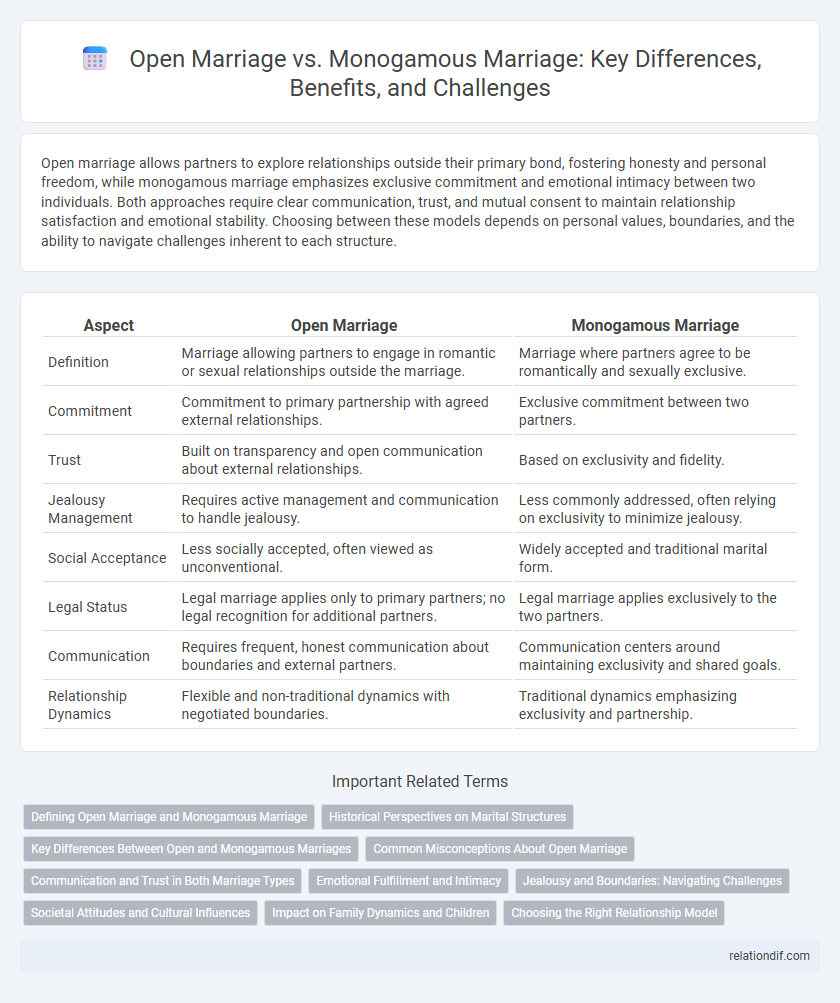Open marriage allows partners to explore relationships outside their primary bond, fostering honesty and personal freedom, while monogamous marriage emphasizes exclusive commitment and emotional intimacy between two individuals. Both approaches require clear communication, trust, and mutual consent to maintain relationship satisfaction and emotional stability. Choosing between these models depends on personal values, boundaries, and the ability to navigate challenges inherent to each structure.
Table of Comparison
| Aspect | Open Marriage | Monogamous Marriage |
|---|---|---|
| Definition | Marriage allowing partners to engage in romantic or sexual relationships outside the marriage. | Marriage where partners agree to be romantically and sexually exclusive. |
| Commitment | Commitment to primary partnership with agreed external relationships. | Exclusive commitment between two partners. |
| Trust | Built on transparency and open communication about external relationships. | Based on exclusivity and fidelity. |
| Jealousy Management | Requires active management and communication to handle jealousy. | Less commonly addressed, often relying on exclusivity to minimize jealousy. |
| Social Acceptance | Less socially accepted, often viewed as unconventional. | Widely accepted and traditional marital form. |
| Legal Status | Legal marriage applies only to primary partners; no legal recognition for additional partners. | Legal marriage applies exclusively to the two partners. |
| Communication | Requires frequent, honest communication about boundaries and external partners. | Communication centers around maintaining exclusivity and shared goals. |
| Relationship Dynamics | Flexible and non-traditional dynamics with negotiated boundaries. | Traditional dynamics emphasizing exclusivity and partnership. |
Defining Open Marriage and Monogamous Marriage
Open marriage is a consensual relationship where partners agree to engage in romantic or sexual relationships outside their primary bond, emphasizing communication and mutual consent. Monogamous marriage is a union between two partners committed exclusively to each other, prioritizing emotional and physical fidelity. These models reflect differing approaches to trust, commitment, and relationship boundaries in marriage.
Historical Perspectives on Marital Structures
Historical perspectives on marital structures reveal that monogamous marriage has been the dominant model in many Western societies for centuries, rooted in religious and legal frameworks prioritizing exclusive partnership. In contrast, open marriages trace back to various indigenous cultures and alternative communities where non-monogamous arrangements were normalized for social, economic, or spiritual reasons. Understanding these diverse historical contexts challenges modern assumptions and highlights the fluidity of marital norms across time and cultures.
Key Differences Between Open and Monogamous Marriages
Open marriages allow partners to pursue romantic or sexual relationships outside their primary union, emphasizing transparency and negotiated boundaries, whereas monogamous marriages are centered on exclusive commitment between two individuals. Communication patterns differ significantly, with open marriages requiring explicit agreements on rules and emotional management, while monogamous relationships prioritize fidelity and singular partnership. The key distinctions also include varying perceptions of trust, jealousy, and relationship security, influencing the emotional dynamics and long-term stability of each marriage type.
Common Misconceptions About Open Marriage
Open marriage is often misunderstood as merely synonymous with promiscuity or lack of commitment, but in reality, it involves negotiated boundaries and mutual consent between partners. Contrary to common misconceptions, many open marriages prioritize honesty, communication, and emotional intimacy just as much as monogamous relationships do. Research indicates that couples in open marriages can experience comparable levels of relationship satisfaction and trust, challenging traditional assumptions about exclusivity and fidelity.
Communication and Trust in Both Marriage Types
Communication and trust are foundational in both open and monogamous marriages, yet they manifest differently. In open marriages, clear boundaries and constant dialogue are essential to maintain trust amid multiple relationships. Monogamous marriages often build trust through exclusivity and consistent emotional intimacy, reinforcing commitment through shared experiences and honest communication.
Emotional Fulfillment and Intimacy
Open marriages often provide partners with diverse sources of emotional fulfillment and intimacy by allowing multiple connections, which can reduce feelings of confinement and increase personal growth. Monogamous marriages typically foster deep emotional bonds and exclusive intimacy, creating a secure and focused environment for trust and vulnerability. Both models cater to emotional needs differently, with open marriages emphasizing variety and autonomy, while monogamy emphasizes exclusivity and stability.
Jealousy and Boundaries: Navigating Challenges
Open marriages require clear communication and well-defined boundaries to manage jealousy effectively, fostering trust and emotional security between partners. In contrast, monogamous marriages often rely on exclusivity as a primary boundary, which can limit exposure to jealousy triggers but may not eliminate them entirely. Successful navigation of jealousy in both types depends on mutual understanding, emotional honesty, and consistent reassurance.
Societal Attitudes and Cultural Influences
Societal attitudes toward open marriage often vary significantly across cultures, with more liberal societies showing increasing acceptance compared to traditional views favoring monogamous marriage. Cultural influences such as religion, media representation, and historical norms heavily shape perceptions, often framing monogamous marriage as the social standard while open marriages face stigma or misunderstanding. Research from the Pew Research Center indicates that younger generations tend to be more open to alternative relationship structures, reflecting shifting cultural narratives around commitment and fidelity.
Impact on Family Dynamics and Children
Open marriages can introduce complex family dynamics due to varied boundaries, potentially affecting children's understanding of commitment and stability, while monogamous marriages often provide a more predictable environment that supports traditional values and clear role modeling. Children in monogamous families may experience a consistent parental structure which can contribute to emotional security and developmental stability, whereas those in open marriages might encounter challenges related to shifting parental relationships and social perceptions. Research indicates that the clarity of relationship expectations rather than the marriage type itself significantly impacts children's well-being and family cohesion.
Choosing the Right Relationship Model
Selecting the right relationship model depends on individual values, communication styles, and long-term goals. Open marriages offer flexibility and the potential for diverse emotional connections, while monogamous marriages prioritize exclusivity and deepening a singular bond. Couples should evaluate trust levels, personal boundaries, and compatibility to determine which arrangement fosters mutual satisfaction and growth.
open marriage vs monogamous marriage Infographic

 relationdif.com
relationdif.com